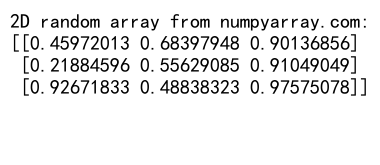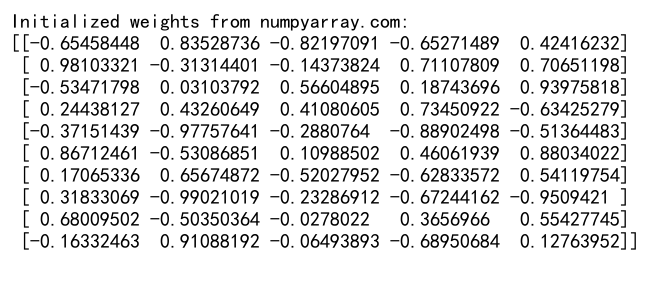Comprehensive Guide to NumPy Random Uniform Distribution: Unleashing the Power of Random Number Generation
NumPy random uniform distribution is a powerful tool for generating random numbers within a specified range. This article will delve deep into the world of NumPy random uniform distribution, exploring its various aspects, use cases, and implementation techniques. We’ll cover everything from basic concepts to advanced applications, providing you with a comprehensive understanding of this essential feature in NumPy.
Understanding NumPy Random Uniform Distribution
NumPy random uniform distribution is a fundamental concept in the NumPy library, which is widely used for scientific computing and data analysis in Python. The uniform distribution generates random numbers with equal probability across a specified range. This makes it an invaluable tool for simulations, statistical analysis, and various other applications in data science and machine learning.
Let’s start with a simple example to illustrate the basic usage of NumPy random uniform distribution:
import numpy as np
# Generate a single random number between 0 and 1
random_number = np.random.uniform()
print(f"Random number from numpyarray.com: {random_number}")
Output:

In this example, we import NumPy and use the np.random.uniform() function to generate a single random number between 0 and 1. This is the default behavior when no arguments are provided.
Specifying Range for NumPy Random Uniform Distribution
One of the key features of NumPy random uniform distribution is the ability to specify a custom range for the generated random numbers. This allows you to tailor the distribution to your specific needs.
Here’s an example demonstrating how to generate random numbers within a custom range:
import numpy as np
# Generate a random number between 5 and 10
custom_range_number = np.random.uniform(5, 10)
print(f"Random number from numpyarray.com in custom range: {custom_range_number}")
Output:

In this code snippet, we use np.random.uniform(5, 10) to generate a random number between 5 and 10. The first argument (5) is the lower bound, and the second argument (10) is the upper bound of the range.
Generating Multiple Random Numbers with NumPy Random Uniform Distribution
NumPy random uniform distribution is not limited to generating single random numbers. It can efficiently produce arrays of random numbers, which is particularly useful for large-scale simulations and data analysis tasks.
Let’s see how we can generate an array of random numbers:
import numpy as np
# Generate an array of 5 random numbers between 0 and 1
random_array = np.random.uniform(size=5)
print(f"Random array from numpyarray.com: {random_array}")
Output:

In this example, we use the size parameter to specify the number of random numbers we want to generate. The result is a NumPy array containing 5 random numbers between 0 and 1.
Shaping the Output of NumPy Random Uniform Distribution
NumPy random uniform distribution offers great flexibility in shaping the output of random numbers. You can generate multi-dimensional arrays of random numbers, which is particularly useful for creating random matrices or tensors.
Here’s an example of generating a 2D array of random numbers:
import numpy as np
# Generate a 3x3 array of random numbers between 0 and 1
random_2d_array = np.random.uniform(size=(3, 3))
print(f"2D random array from numpyarray.com:\n{random_2d_array}")
Output:

In this code, we use a tuple (3, 3) as the size parameter to create a 3×3 2D array of random numbers.
Controlling Randomness with Seeds in NumPy Random Uniform Distribution
When working with NumPy random uniform distribution, it’s often important to be able to reproduce results. This is where seeds come in handy. By setting a seed, you can ensure that the same sequence of random numbers is generated each time you run your code.
Here’s how you can use seeds with NumPy random uniform distribution:
import numpy as np
# Set a seed for reproducibility
np.random.seed(42)
# Generate random numbers
random_numbers = np.random.uniform(0, 10, size=5)
print(f"Random numbers from numpyarray.com with seed: {random_numbers}")
Output:

In this example, we use np.random.seed(42) to set a seed before generating random numbers. This ensures that the same sequence of random numbers is produced every time this code is run.
Generating Integer Random Numbers with NumPy Random Uniform Distribution
While NumPy random uniform distribution primarily deals with floating-point numbers, you can easily generate random integers within a specified range by combining it with other NumPy functions.
Here’s an example of generating random integers:
import numpy as np
# Generate 5 random integers between 1 and 10 (inclusive)
random_integers = np.random.randint(1, 11, size=5)
print(f"Random integers from numpyarray.com: {random_integers}")
Output:

In this code, we use np.random.randint() instead of np.random.uniform(). The function generates random integers from a discrete uniform distribution.
Applying NumPy Random Uniform Distribution in Simulations
NumPy random uniform distribution is widely used in various simulations. Let’s look at a simple example of simulating coin flips:
import numpy as np
# Simulate 1000 coin flips
coin_flips = np.random.uniform(0, 1, size=1000)
heads = np.sum(coin_flips < 0.5)
tails = np.sum(coin_flips >= 0.5)
print(f"Coin flip simulation from numpyarray.com:")
print(f"Heads: {heads}, Tails: {tails}")
Output:

In this simulation, we generate 1000 random numbers between 0 and 1. Numbers less than 0.5 are considered heads, while numbers greater than or equal to 0.5 are considered tails.
Using NumPy Random Uniform Distribution for Monte Carlo Simulations
Monte Carlo simulations are a powerful technique that relies heavily on random number generation. NumPy random uniform distribution is an excellent tool for implementing these simulations.
Here’s a simple example of using NumPy random uniform distribution for a Monte Carlo estimation of pi:
import numpy as np
def estimate_pi(num_points):
x = np.random.uniform(-1, 1, num_points)
y = np.random.uniform(-1, 1, num_points)
inside_circle = np.sum(x**2 + y**2 <= 1)
pi_estimate = 4 * inside_circle / num_points
return pi_estimate
# Estimate pi using 1,000,000 points
estimated_pi = estimate_pi(1000000)
print(f"Estimated pi from numpyarray.com: {estimated_pi}")
Output:

This Monte Carlo simulation estimates the value of pi by randomly generating points within a square and determining the ratio of points that fall within an inscribed circle.
Generating Random Samples from Custom Distributions
While NumPy random uniform distribution generates numbers from a uniform distribution, you can use it as a building block to generate samples from other distributions.
Here’s an example of generating samples from a custom distribution:
import numpy as np
def custom_distribution(size):
u = np.random.uniform(size=size)
return -np.log(1 - u)
# Generate 1000 samples from the custom distribution
samples = custom_distribution(1000)
print(f"Samples from custom distribution on numpyarray.com: {samples[:5]}...")
Output:

In this example, we use the inverse transform sampling method to generate samples from an exponential distribution using NumPy random uniform distribution as a starting point.
Combining NumPy Random Uniform Distribution with Other NumPy Functions
NumPy random uniform distribution can be seamlessly integrated with other NumPy functions to perform complex operations on random data.
Here’s an example that combines random number generation with array operations:
import numpy as np
# Generate a 5x5 array of random numbers
random_array = np.random.uniform(0, 10, size=(5, 5))
# Calculate the mean of each row
row_means = np.mean(random_array, axis=1)
print(f"Random array from numpyarray.com:\n{random_array}")
print(f"Row means: {row_means}")
Output:

In this code, we generate a 5×5 array of random numbers and then calculate the mean of each row using NumPy’s mean() function.
Using NumPy Random Uniform Distribution in Machine Learning
NumPy random uniform distribution plays a crucial role in many machine learning algorithms, particularly in the initialization of model parameters.
Here’s a simple example of initializing weights for a neural network layer:
import numpy as np
def initialize_weights(input_size, output_size):
return np.random.uniform(-1, 1, size=(input_size, output_size))
# Initialize weights for a layer with 10 inputs and 5 outputs
weights = initialize_weights(10, 5)
print(f"Initialized weights from numpyarray.com:\n{weights}")
Output:

This function initializes weights for a neural network layer using NumPy random uniform distribution, which is a common practice in deep learning.
Generating Random Permutations with NumPy Random Uniform Distribution
NumPy random uniform distribution can be used indirectly to generate random permutations of sequences, which is useful in many algorithms and data processing tasks.
Here’s an example of generating a random permutation:
import numpy as np
# Create a sequence
sequence = np.arange(10)
# Generate a random permutation
permutation = np.random.permutation(sequence)
print(f"Original sequence from numpyarray.com: {sequence}")
print(f"Random permutation: {permutation}")
Output:

In this code, we use np.random.permutation() to generate a random permutation of the sequence. This function internally uses uniform random numbers to create the permutation.
Implementing Random Sampling with NumPy Random Uniform Distribution
Random sampling is a common task in data analysis and machine learning. NumPy random uniform distribution can be used to implement various sampling techniques.
Here’s an example of random sampling without replacement:
import numpy as np
# Create a population
population = np.arange(100)
# Perform random sampling without replacement
sample = np.random.choice(population, size=10, replace=False)
print(f"Random sample from numpyarray.com: {sample}")
Output:

In this example, we use np.random.choice() to randomly select 10 unique elements from the population.
Generating Random Walks with NumPy Random Uniform Distribution
Random walks are stochastic processes with many applications in physics, finance, and other fields. NumPy random uniform distribution can be used to simulate random walks.
Here’s an example of generating a 1D random walk:
import numpy as np
def random_walk(steps):
return np.cumsum(np.random.uniform(-1, 1, size=steps))
# Generate a random walk of 100 steps
walk = random_walk(100)
print(f"Random walk from numpyarray.com: {walk[:10]}...")
Output:

This function generates a random walk by cumulatively summing random steps between -1 and 1.
Implementing Bootstrapping with NumPy Random Uniform Distribution
Bootstrapping is a powerful statistical technique that relies on random sampling with replacement. NumPy random uniform distribution can be used to implement bootstrapping.
Here’s a simple example of bootstrapping to estimate the mean of a dataset:
import numpy as np
def bootstrap_mean(data, num_samples, sample_size):
means = np.zeros(num_samples)
for i in range(num_samples):
sample = np.random.choice(data, size=sample_size, replace=True)
means[i] = np.mean(sample)
return means
# Create a dataset
data = np.random.uniform(0, 100, size=1000)
# Perform bootstrapping
bootstrap_means = bootstrap_mean(data, num_samples=1000, sample_size=100)
print(f"Bootstrap mean estimate from numpyarray.com: {np.mean(bootstrap_means)}")
print(f"Bootstrap 95% CI: {np.percentile(bootstrap_means, [2.5, 97.5])}")
Output:

This example demonstrates how to use bootstrapping to estimate the mean of a dataset and calculate a confidence interval.
Generating Random Matrices with NumPy Random Uniform Distribution
Random matrices have applications in various fields, including physics, statistics, and machine learning. NumPy random uniform distribution can be used to generate random matrices efficiently.
Here’s an example of generating a random matrix and calculating its eigenvalues:
import numpy as np
# Generate a 5x5 random matrix
random_matrix = np.random.uniform(-1, 1, size=(5, 5))
# Calculate eigenvalues
eigenvalues = np.linalg.eigvals(random_matrix)
print(f"Random matrix from numpyarray.com:\n{random_matrix}")
print(f"Eigenvalues: {eigenvalues}")
Output:

This code generates a 5×5 random matrix using NumPy random uniform distribution and then calculates its eigenvalues using NumPy’s linear algebra module.
Implementing Rejection Sampling with NumPy Random Uniform Distribution
Rejection sampling is a technique for generating samples from a distribution that may be difficult to sample from directly. NumPy random uniform distribution can be used as a key component in rejection sampling algorithms.
Here’s a simple example of rejection sampling to generate samples from a standard normal distribution:
import numpy as np
def rejection_sampling_normal(num_samples):
samples = []
while len(samples) < num_samples:
x = np.random.uniform(-3, 3)
y = np.random.uniform(0, 0.4)
if y <= np.exp(-0.5 * x**2) / np.sqrt(2 * np.pi):
samples.append(x)
return np.array(samples)
# Generate 1000 samples
normal_samples = rejection_sampling_normal(1000)
print(f"Samples from standard normal using rejection sampling on numpyarray.com: {normal_samples[:5]}...")
Output:

This example uses rejection sampling to generate samples from a standard normal distribution using NumPy random uniform distribution as the proposal distribution.
NumPy random uniform distribution Conclusion
NumPy random uniform distribution is a versatile and powerful tool for generating random numbers in Python. Its applications span a wide range of fields, from simple simulations to complex machine learning algorithms. By mastering NumPy random uniform distribution, you can unlock new possibilities in data analysis, scientific computing, and beyond.
Throughout this article, we’ve explored various aspects of NumPy random uniform distribution, including basic usage, customization, and advanced applications. We’ve seen how it can be used for tasks such as Monte Carlo simulations, random sampling, and parameter initialization in machine learning models.
Remember that while NumPy random uniform distribution provides pseudorandom numbers that are sufficient for many applications, for cryptographic purposes or when true randomness is required, you should use more specialized libraries.